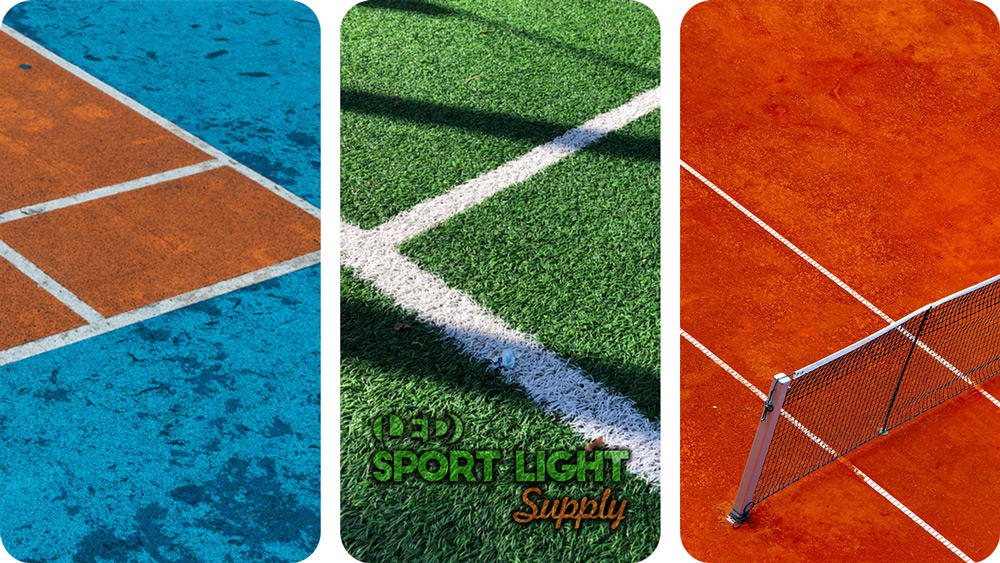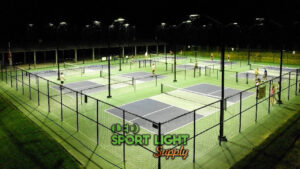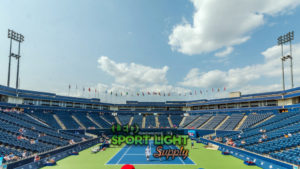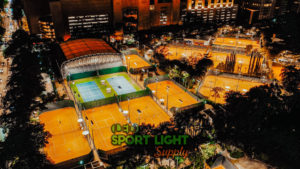There are four main types of tennis court, namely clay court, hard court, grass court and carpet. How to light up these tennis court? Are there any special specifications or considerations when installing the tennis court lighting? This article is designed for you if you have the above doubts. Plus, we will also discuss the characteristics of these four types of tennis courts, says the ball bounce, shock absorption, friction and more.
1. Clay court
Characteristics
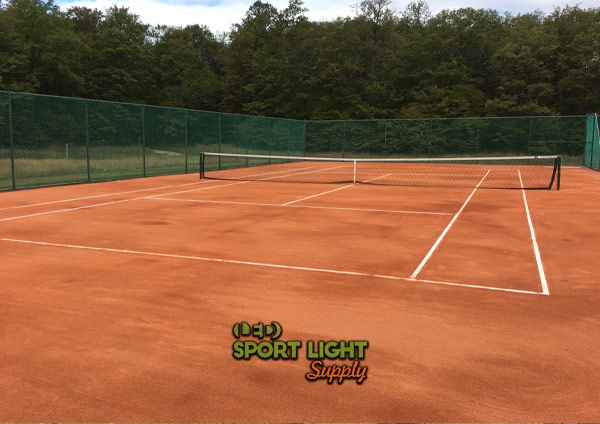 Depending on which country that uses clay courts, the type of clay will vary in color but not so much for overall texture. Both Europe and South America are more typical for seeing clay courts using crushed brick and shale, or basalt. Red courts use crushed brick and shale while blue courts use basalt and crushed brick. Each court is then smoothed using a heavy roller.
Depending on which country that uses clay courts, the type of clay will vary in color but not so much for overall texture. Both Europe and South America are more typical for seeing clay courts using crushed brick and shale, or basalt. Red courts use crushed brick and shale while blue courts use basalt and crushed brick. Each court is then smoothed using a heavy roller.
Effect of tennis player and ball bounce
Clay courts are best for those who are better at playing defense since it’s easier to slide into their return. It also affects the bounce of a tennis ball which is often higher, but slower as a result. One main disadvantage is on player service since this surface often takes away from players who like dominating harder surfaces. This usually gives the defensive player the upper hand on any defense return shot.
How clay surfaces affect lighting and performance
The advantage of clay is that this material is non-reflective and absorbs light nicely. Because clay is a natural material it tends to kick up dust more often. This means that outdoor lighting will reflect off dust and create a hazy effect until it settles. Synthetic clay surfaces are better suited since these are bonded to the court floor. While this is good for grip, natural clay will have visibility issues if too much dust is kicked-up.
The dust particles of clay aren’t light-absorbing however this may be problematic if the powder-like surface coating lingers. It can make a tennis court surface appear foggy in spots impairing the visual depth needed to play. In a heated match, the amount of clay dust that is seen from overhead lighting will be obvious and annoying. Clay is often used outside but is better managed for indoor use due to moisture control.
2. Hard court
Characteristics
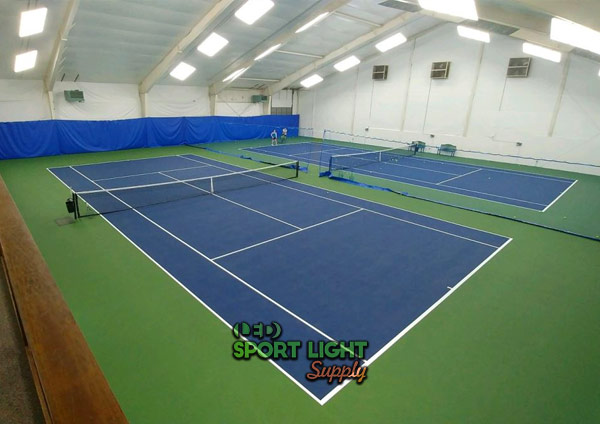 The surface used for a hard court is often mixed depending on preference. It can simply be a sheet of concrete or asphalt over concrete. Most courts will then add a layer of synthetic material mixed with sand to add a gravel color. While these colors will vary from red, green, or blue, this adds a sandy grip for players.
The surface used for a hard court is often mixed depending on preference. It can simply be a sheet of concrete or asphalt over concrete. Most courts will then add a layer of synthetic material mixed with sand to add a gravel color. While these colors will vary from red, green, or blue, this adds a sandy grip for players.
Effect of tennis player and ball bounce
Harder courts have less absorption, so the play is faster with higher bounces of a tennis ball. This allows players to focus on the spin that can be put on a ball to gain their advantage. There is a bit more impact absorption if the sand coating is thicker, adding friction that leads to slower bounces. These types of hard courts are often called Democratic courts because of their universal appeal for tennis players.
How hard surfaces affect lighting and performance
Having a hard court is great for outdoor lighting since the artificial texture that’s added absorbs any light. It also lights-up the color of the textured sand nicely making it easier to spot the ball. There is never any kind of glare on tennis court surface since the sand deflects light waves and absorbs directly into the surface. If only concrete is laid down, this can present an issue if the surface is smooth, which is uncommon.
Tennis courts often have a sand-based paint that gives better grip but also serves to deflect the glare. Even for asphalt surfaces, it’s common to use a special tennis court paint to complete the job. Once the paint dries it’s impossible to catch glare due to the sand that’s added for indoor or outdoor use.
3. Grass court
Characteristics
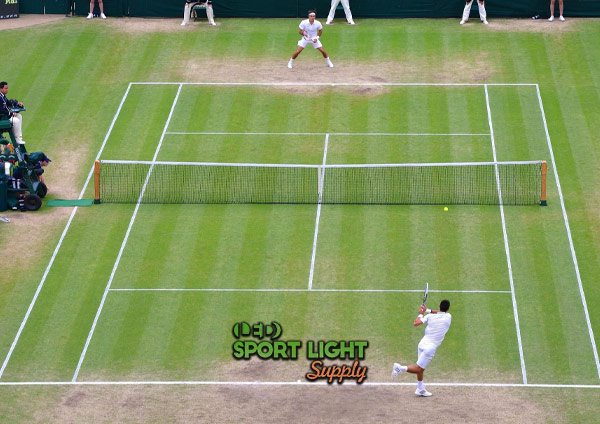 Some advantages allow players to take advantage of grass surfaces since it’s a softer medium than hard courts. But this all depends on how compacted the soil is, how often the grass is mowed, and moisture levels. There are also issues with how often matches are played on a fresh court or how healthy the grass is. Any of these factors determine the outcome of the ball’s bounce.
Some advantages allow players to take advantage of grass surfaces since it’s a softer medium than hard courts. But this all depends on how compacted the soil is, how often the grass is mowed, and moisture levels. There are also issues with how often matches are played on a fresh court or how healthy the grass is. Any of these factors determine the outcome of the ball’s bounce.
Effect of tennis player and ball bounce
For the most part, bounces are faster but lower due to the soil and grass density. This gives an advantage for servers, although for volley shots; defense shots can be equally returned and dominated. Grass courts are great for sliding into a shot, yet higher moisture levels can become slippery in the rain. The Grand Slam championship in Wimbledon is known for scattered showers and poor rainy weather.
How grass surfaces affect lighting and performance
There is one major problem with grass since it is a living type of plant. The blades of grass are smooth and slick looking, creating glare conditions if the light is at the right angle. The problem is that each blade of grass will be stepped on during a tennis match. This changes the angles of each blade ever-so-slightly and can reflect light that is coming from above. It can create a blind spot that forms into reflecting patches for a player. It can’t always be measured since grass blades return to their upright position at first.
But with repeated trampling, blades will lay lower and lower and create the potential for blinding glare. Nighttime play can be a problem if moisture in the air forms on the grass forming dew. This water vapor makes grass blades glisten in any light and is also very slippery.
4. Carpet court
Characteristics
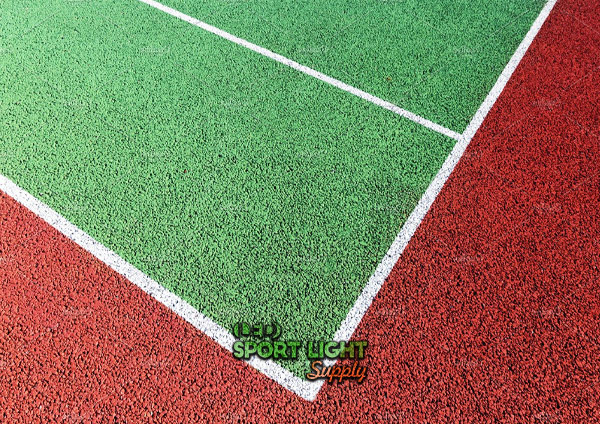 This is any type of covering that is rolled onto a standard hard tennis court. It simulates grass to varying thicknesses similar to Astroturf but isn’t limited to surface texture or materials it’s constructed from. This material is often used for indoor tennis courts but has been banned by the Association of Tennis Professionals (ATP) from use in tournaments.
This is any type of covering that is rolled onto a standard hard tennis court. It simulates grass to varying thicknesses similar to Astroturf but isn’t limited to surface texture or materials it’s constructed from. This material is often used for indoor tennis courts but has been banned by the Association of Tennis Professionals (ATP) from use in tournaments.
Effect of tennis player and ball bounce
The effect that carpet courts are very similar to grass which absorbs the energy of the ball. Serves can be faster and lower and be an advantage for players who are better at spotting a volley opportunity. The downside to carpet courts is that regular tennis shoes are not recommended since the grip leads to injuries. Special carpet shoes were developed, helping increase slide control; but it comes down to thickness and carpet age too.
How carpet surfaces affect lighting and performance
You won’t find much glare from carpet material since these surfaces are always matt colored. Depending on how old the material may be, some surfaces that are more compacted can become slightly reflective. This doesn’t happen so often since these carpets are cleaned using industrial rotating carpet cleaners. These help to fluff up the carpet surface and reduce sunken areas.
Materials that are made from plastic materials wear-out sooner such as artificial turf that can become reflective. This is when it gets matted after a while and the material picks-up reflection from overhead lights. Artificial turf is more problematic for outdoor reflectivity issues.

